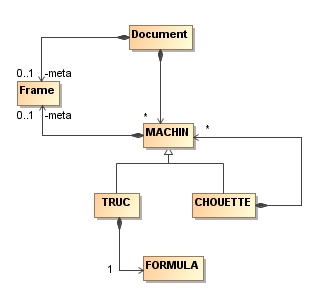- From: Christian de Sainte Marie <csma@ilog.fr>
- Date: Mon, 28 Apr 2008 20:12:28 +0200
- To: Christian de Sainte Marie <csma@ilog.fr>
- CC: Michael Kifer <kifer@cs.sunysb.edu>, Sandro Hawke <sandro@w3.org>, "Boley, Harold" <Harold.Boley@nrc-cnrc.gc.ca>, public-rif-wg@w3.org
- Message-ID: <4816138C.3090601@ilog.fr>
Christian de Sainte Marie wrote: > > Or replace them all by an abstract construct that could be specialised > into Groups, Rules, Facts, Whachamacallit etc in concrete dialects; To make my point more clearly, and, hopefully to help progress the discussion, here is a diagram 5 of FLD with only abstract classes for the content of a Document: a RIF Document contains zero to many objects of the abstract class MACHIN, which can be subdivided into objects of the abstract class TRUC and objects of the abstract class CHOUETTE. A Document can have metadata attached, as does any (concrete) object of a MACHIN class as well, but this might actually be orthogonal to the discussion (as I suspect Paul is arguing in the part of his email that I did not read yet :-) The main difference between the TRUC and CHOUETTE (abstract) subclasses of MACHIN is whether they recurse (on MACHIN) or not: TRUC does not and CHOUETTE does. So, TRUC concrete classes are FORMULA classifiers, whereas CHOUETTE concrete classes are classifiers of FORMULA grouping concepts. Another difference is that TRUC (concrete) objects are directly associated to a FORMULA, whereas CHOUETTE objects are associated to groups of FORMULAs only via the concrete classifiers of the TRUC class, if any. Now, what if FLD could specify only these abstract constructs, with whatever names seem most appropriate, and leave it to concrete dialect to specify the concrete classes they need? One dialect, say: BLD, could use one CHOUETTE concrete class called Group, and two concrete TRUC classes called Rule and Fact; whereas another dialect, say: PRD, could have only one concrete TRUC class called Rule and no concrete class for CHOUETTE at all. Yet another concrete dialect could have only one concrete CHOUETTE class (Group) and no concrete TRUC class: Group vould thus contain zero or many Groups or FORMULAs, as is the case in the current draft of BLD and FLD... Would something like that work? Or be amenable to work? And would it help resolve the ISSUE 51? Cheers, Christian
Attachments
- image/jpeg attachment: Diagram_5__FLD_with_abstract_classes_.jpg

Received on Monday, 28 April 2008 18:12:33 UTC